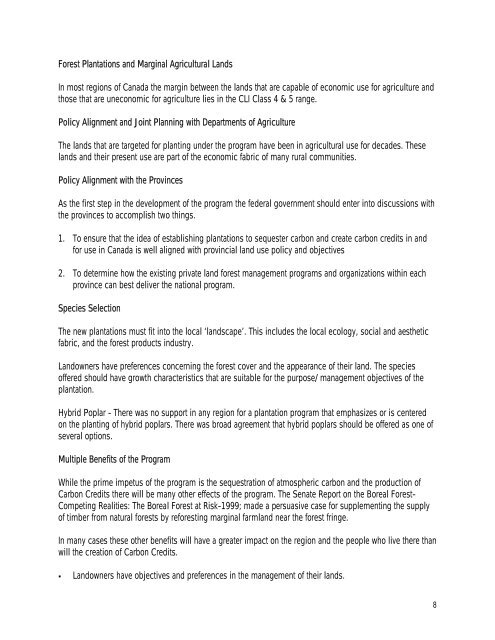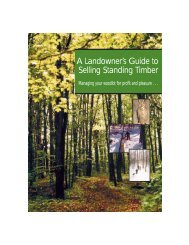Canada's Privately Owned Forest Lands: - Ontario woodlot.com
Canada's Privately Owned Forest Lands: - Ontario woodlot.com
Canada's Privately Owned Forest Lands: - Ontario woodlot.com
- No tags were found...
Create successful ePaper yourself
Turn your PDF publications into a flip-book with our unique Google optimized e-Paper software.
<strong>Forest</strong> Plantations and Marginal Agricultural <strong>Lands</strong>In most regions of Canada the margin between the lands that are capable of economic use for agriculture andthose that are uneconomic for agriculture lies in the CLI Class 4 & 5 range.Policy Alignment and Joint Planning with Departments of AgricultureThe lands that are targeted for planting under the program have been in agricultural use for decades. Theselands and their present use are part of the economic fabric of many rural <strong>com</strong>munities.Policy Alignment with the ProvincesAs the first step in the development of the program the federal government should enter into discussions withthe provinces to ac<strong>com</strong>plish two things.1. To ensure that the idea of establishing plantations to sequester carbon and create carbon credits in andfor use in Canada is well aligned with provincial land use policy and objectives2. To determine how the existing private land forest management programs and organizations within eachprovince can best deliver the national program.Species SelectionThe new plantations must fit into the local ‘landscape’. This includes the local ecology, social and aestheticfabric, and the forest products industry.Landowners have preferences concerning the forest cover and the appearance of their land. The speciesoffered should have growth characteristics that are suitable for the purpose/ management objectives of theplantation.Hybrid Poplar - There was no support in any region for a plantation program that emphasizes or is centeredon the planting of hybrid poplars. There was broad agreement that hybrid poplars should be offered as one ofseveral options.Multiple Benefits of the ProgramWhile the prime impetus of the program is the sequestration of atmospheric carbon and the production ofCarbon Credits there will be many other effects of the program. The Senate Report on the Boreal <strong>Forest</strong>-Competing Realities: The Boreal <strong>Forest</strong> at Risk-1999; made a persuasive case for supplementing the supplyof timber from natural forests by reforesting marginal farmland near the forest fringe.In many cases these other benefits will have a greater impact on the region and the people who live there thanwill the creation of Carbon Credits.! Landowners have objectives and preferences in the management of their lands.8
















